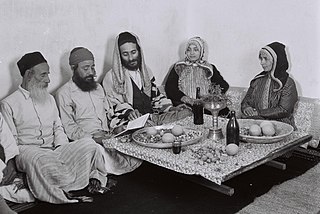| Regions with significant populations | |
|---|---|
| Arusha | |
| Languages | |
| English, Swahili, Hebrew | |
| Religion | |
| Judaism |
| Part of a series on |
| Jews and Judaism |
|---|
The history of the Jews in Tanzania dates back at least to the 1880s, when Yemenite, Ethiopian, and Omani Jews arrived in Tanzania. A later influx of Polish and German Jews settled in Tanzania between the 1930s and the 1950s, fleeing persecution in Nazi Europe.
A Jewish community has existed in the city of Arusha for over a century. The Jewish community of Arusha was founded by Yemenite Jews who had crossed the Gulf of Aden in the 1880s, passing through Ethiopia and Kenya before settling in Tanzania. Moroccan, Omani, and Ethiopian Jews also settled in Arusha. Many were from the towns of Mawza and Sanaa. Some Yemenites from Zanzibar also later moved to Arusha. During the 1930s, around 5,000 Polish Jews fleeing Nazi persecution joined the Arusha Jewish community. Due to antisemitism, the Jewish community kept a low profile. Due to antisemitic violence and aggressive missionary activities, the community began to disperse during the 1960s. The synagogue in Arusha was destroyed and its Sefer Torah burned. Political and economic instability following Tanzania's independence in 1961 motivated many Tanzanian Jews to leave the country. Some Jews who remained practiced Judaism in secret or joined the Maasai people. [1]
In 2018, Chabad-Lubavitch of Zanzibar was established as the first Jewish center in the Muslim-majority province of Zanzibar. [2]
In 2019, Kehillat Beth Israel of Ottawa donated a Sefer Torah to the Jewish community of Arusha. [3]
This is a list of notable events in the development of Jewish history. All dates are given according to the Common Era, not the Hebrew calendar.

Menachem Mendel Schneerson, known to adherents of the Chabad-Lubavitch movement as the Lubavitcher Rebbe or simply the Rebbe, was an Orthodox rabbi and the most recent Rebbe of the Lubavitch Hasidic dynasty. He is considered one of the most influential Jewish leaders of the 20th century.

Chabad, also known as Lubavitch, Habad and Chabad-Lubavitch, is an Orthodox Jewish Hasidic dynasty. Chabad is one of the world's best-known Hasidic movements. It is one of the largest Hasidic groups as well as one of the largest Jewish religious organizations in the world. Unlike most Haredi groups, which are self-segregating, Chabad mainly operates in the wider world and it caters to secularized Jews.

Shneur Zalman of Liadi was a rabbi and the founder and first Rebbe of Chabad, a branch of Hasidic Judaism. He wrote many works, and is best known for Shulchan Aruch HaRav, Tanya, and his Siddur Torah Or compiled according to the Nusach Ari.

Yosef YitzchakSchneersohn was an Orthodox rabbi and the sixth Rebbe of the Chabad Lubavitch Hasidic movement. He is also known as the Frierdiker Rebbe, the Rebbe RaYYaTz, or the Rebbe Rayatz. After many years of fighting to keep Orthodox Judaism alive from within the Soviet Union, he was forced to leave; he continued to conduct the struggle from Latvia, and then Poland, and eventually the United States, where he spent the last ten years of his life.

Yemenite Jews, also known as Yemeni Jews or Teimanim, are those Jews who live, or once lived, in Yemen, and their descendants maintaining their customs. Between June 1949 and September 1950, the overwhelming majority of the country's Jewish population immigrated to Israel in Operation Magic Carpet. After several waves of persecution, the vast majority of Yemenite Jews now live in Israel, while smaller communities live in the United States and elsewhere. As of 2022, only one Jew remained in Yemen.

Sholom Dovber Schneersohn was the fifth rebbe of the Chabad-Lubavitch chasidic movement. He is known as "the Rebbe Rashab". His teachings that encouraged outreach were further developed by later.
Schisms among the Jews are cultural as well as religious. They have happened as a product of historical accident, geography, and theology.
Minhag is an accepted tradition or group of traditions in Judaism. A related concept, Nusach (נוסח), refers to the traditional order and form of the prayers.

A sofer, sopher, sofer SeTaM, or sofer ST"M is a Jewish scribe who can transcribe Sifrei Kodesh, tefillin (phylacteries), mezuzot and other religious writings.

The history of the Jews in Luxembourg dates back to the 1200s. There are roughly 1,200 Jews in Luxembourg, and Jews form one of the largest and most important religious and ethnic minority communities in Luxembourg historically.

Jews in Eritrea can trace their history back to the late 19th century arrival of Yemenite Jews.

The Habbani Jews are a culturally distinct Jewish population group from the Habban region in eastern Yemen, a subset of the larger ethnic group of Yemenite Jews. The city of Habban had a Jewish community of 450 in 1947, which was considered to possibly be the remains of a larger community which lived independently in the region before its decline in the 6th century. The Jewish community of Habban disappeared from the map of the Hadramaut, in southeast Yemen, with the emigration of all of its members to Israel in the 1950s.
The history of the Jews in the United Arab Emirates describes the historical and modern presence of Jews over the millennia in the Middle East and the recorded meetings with Jewish communities in areas that are today in the geographic territories of the United Arab Emirates.

The Jewish community of Houston, Texas has grown and thrived since the 1800s. As of 2008 Jews lived in many Houston neighborhoods and Meyerland is the center of the Jewish community in the area.
The Rohr Jewish Learning Institute (JLI) is a division of Merkos L'Inyonei Chinuch, the educational arm of the Chabad-Lubavitch Orthodox Jewish Hasidic dynasty. It offers adult Jewish courses on Jewish history, law, ethics, philosophy and rabbinical literature worldwide. It also develops Jewish studies curricula specifically for women, college students, teenagers, and seniors.
The history of the Jews in Central Asia dates back centuries, where Jews have lived in countries which include Kyrgyzstan, Kazakhstan, Tajikistan, Turkmenistan, and Uzbekistan.

The Avner Cohen Casa Chabad is a Jewish community centre situated in Cascais in the Lisbon District of Portugal. It includes a library that places special emphasis on works about the Torah, either those written by Portuguese Jewish scholars or printed in Portugal in the late 15th century.
The history of Jews in Somalia refers to the historical presence of Jewish communities in the Horn of Africa country of Somalia.
The history of the Jews in the Gambia dates back to the 16th and 17th centuries, when Sephardi Jewish explorers and traders came to the region of Senegambia. In contemporary Gambia, a Jewish community of local converts has emerged during the 2010s and 2020s.